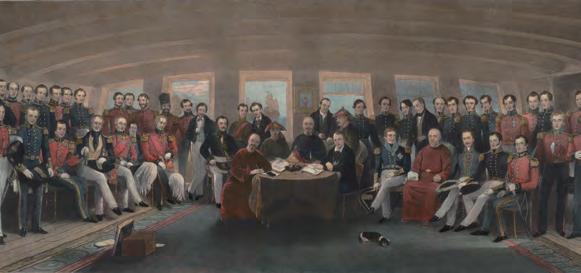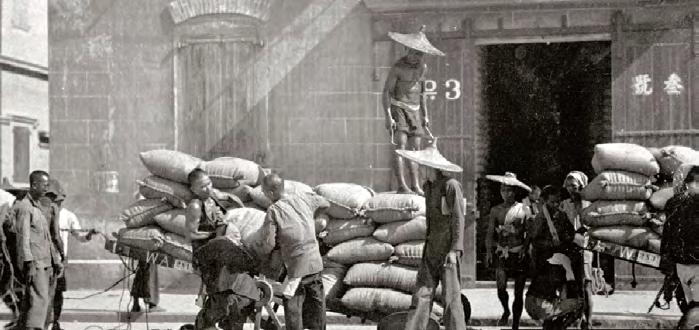
11 minute read
COVER STORY 封面故事
How did Hong Kong become one of the world’s maritime capitals? CityLife retells the city’s illustrious maritime history. 香港是如何成为世界海运之都的?《东方之珠》为您讲述这座 城市辉煌的海事历史。

Advertisement






Hong Kong’s Glorious MARITIME HISTORY

香 港 辉 煌 的 海 事 历 史
The history of Hong Kong is inextricably linked to the sea, maritime trade and its glorious harbour. From the colony’s foundation through to its maritime heyday, Hong Kong’s raison d’etre was as an entrepot between east and west, from which it flourished into one of the great maritime capitals of the world. Vibrant Victoria Harbour, teeming with vessels and water-based activity of all kinds, exuded an Oriental mystique that attracted travellers from around the world. While the harbour is much quieter now, Hong Kong’s port remains one of the world’s largest and the city is still an important maritime centre.
The maritime history of Hong Kong, in which a few scattered backwater fishing villages became one of the world’s great ports, is a fascinating tale. It is a story of favourable geography, fortuitous circumstances, and above all, industrious and enterprising people who, in little more than a century, built the seaborne trade legacy that all Hongkongers can be immensely proud of. We are happy to recount their story. So, let us trace and relive the glorious maritime history on which modern Hong Kong is founded.
The Beginning 開始 – 广东体系 The Canton System
From the mid-18th to mid-19th centuries, during the Qing Dynasty, trading between European nations and China expanded and became increasingly unruly. The imperial Chinese government responded by designating the city of Canton (Guangzhou) as an exclusive enclave for China’s trade with the West, aiming to secure better control. The banks of the Whampoa River were chockful of docks, piers, godowns and trading houses, with trading ships arriving from all corners of the world, thirsty for China’s tea, silk and ceramics. The First Opium War between the United Kingdom and China, from 1839 to 1842, and the subsequent Treaty of Nanking effectively abolished the Canton System, opened other trading ports, and eliminated the trading monopolies of the thirteen local cohongs. Canton’s decline was hastened by a large fire along the river that destroyed many of the warehouses. As part of the treaty, Hong Kong Island was ceded to the UK in perpetuity, and many of the British and Chinese merchants promptly moved their operations to Hong Kong, kickstarting Hong Kong’s rise as a thriving trading port.
In hindsight, it is easy to see that Hong Kong was blessed with prime location, excellent geography, and the timely arrival of the British. At the mouth of the Pearl River Delta, Hong Kong was endowed with a large, deep, nicely sheltered harbour and other coves and bays along its meandering coastline in the lee of the island’s mountainous terrain. While people living in Hong Kong had long conducted rudimentary river and littoral trade with neighbouring villages and cities, from the 1830s, the British recognised Hong Kong’s great geographical advantage, and began to use Hong Kong’s harbour as a “roadstead” where their vessels could shelter. Upon taking over the island, Britain quickly set about making Hong Kong the hub of its Far East trading operations, building basic port facilities, and putting in place the wherewithal for its new acquisition to prosper. 從18世紀中葉到19世紀中葉的清朝時期,歐洲國家與中國之間的貿 易不斷擴大,並且變得越來越難以控制。對此,中國帝國政府作出 回應,將廣州市指定為中國與西方貿易的唯一地點,以確保更好地 控制雙方貿易。黃埔河兩岸到處都是碼頭,貨倉和貿易行,來自世 界各地的商船紛紛抵達於此,渴求中國的茶葉,絲綢和陶瓷。 1839年至1842年中英第一次鴉片戰爭,以及隨後的《南京條約》 廢除了廣州體系,開放了其他貿易港口,並消除了13家當地會所的 貿易壟斷。沿河的一場大火燒毀了許多倉庫,加快了廣州體系的滅 亡。作為條約的一部分,香港島被永久割讓給英國,許多英中商人 在不久後把業務轉移到了香港,香港作為繁榮的貿易港開始崛起。




Location, location, location 地理位置



Early Development 早期發展 – 香港成熟 Hong Kong’s coming of age Hong Kong’s Heydaya leading entrepot

The early years of Hong Kong’s maritime development were not all smooth sailing. The colonial government faced myriad issues creating a functioning city – including construction of utilities and the establishment of a working waterfront, especially through land reclamation that allowed for building dockyards and piers. The administration needed to attract both foreign trading companies and local merchants, and have them work symbiotically. It was a constant challenge to accommodate the tens of thousands who flocked to Hong Kong to supply the needed labour. And then there was piracy – a constant menace to merchant ships along the coastal waterways. Over the decades, these challenges were all overcome and Hong Kong began to take off as a vibrant, thriving port city.
香港的鼎盛時期 – 主要的转口港
If Hong Kong's nineteenth-century emergence as a maritime trading centre had been impressive, the best was still to come. It was the halfcentury from the 1920s to the early 1970s – excepting three years of wartime Japanese occupation – that saw the plucky colony reap the rewards of its effort thus far. Aligned with expanding global trade, and always with a view to developments in its mighty neighbour China, Hong Kong grew and prospered, entering international consciousness as that far-flung speck of land that stood tall in global economics and trade. And the heart of that success was always its relationship with the sea.



Shipbuilding 造船业
Did you know that Hong Kong was once a major shipbuilding centre? In the early 1900s, two of Asia’s leading shipyards were located here – the Hong Kong & Whampoa Dock (in modern Hung Hom) and Taikoo Dockyard (now Tai Koo Shing), the former being where some of the world’s largest cargo vessels and warships were built. 您知道香港曾經是主要的造 船中心嗎?20世紀初期, 亞洲兩個主要的造船廠就坐 落在這裡——香港和黃埔船 塢(現為紅磡)和太古船塢 (現為太古城),前者建造 過世界上最大的貨船和軍艦 所在地。
The frenetic harbour scenes of yesteryear were a mesmerising sight, with vessels large and small jostling for space and right of way in Victoria Harbour. Majestic ocean-going liners regularly visited Hong Kong, docking at the Ocean Terminal in Tsim Sha Tsui; cargo vessels of all sizes were either docked at piers or moored offshore, to be offloaded by barges and smaller vessels, typically the ubiquitous Hong Kong junk with its iconic sail and high poop deck; scores of ferries of all types criss-crossing the harbour from morning till night – the primary means of transport for people, goods and motor vehicles between Hong Kong Island and Kowloon. There might be an American aircraft carrier moored in the middle of the harbour, just off Wan Chai, while its crew enjoyed R&R ashore, all while thousands of little fishing boats and sampans darted around the busy harbour. It must have been quite a scene to behold.



People
人
Above all, what has sustained Hong Kong as this maritime colossus for so long is its people, who in under two centuries built Hong Kong into this great port and trading hub. In the mix were British, other European, and American traders, local Chinese merchants, shipowners, and above all hundreds of thousands of Chinese workers and labourers, serving as coolies, longshoremen, clerks, seamen and officers, and every other role. It is estimated that well over half a million people in the city were engaged in the maritime industry in the 1960s. The confluence of hardworking ethos and enterprise acumen proved the perfect recipe for success.
最重要的是香港人,在近兩個世紀的時間裡,是他 們把香港建設成為一個偉大的港口和貿易中心。聚 集在一起的有英國人、其他歐洲和美國的商人、當 地的中國商人、船主,尤其是成千上萬的中國勞 工,他們擔任苦力、碼頭工人、職員、海員和官 員,還有其他各種角色。據估計,20世紀60年代, 該市有超過50萬人從事海運業。事實證明,勤奮精 神和企業智慧的融合是成功的完美秘訣。 昔日喧囂的海港景像一定令人着迷,大大小小的船隻在 維多利亞港爭搶空間和通行權。定期到訪香港的雄偉郵 輪,經常停泊在尖沙咀海運碼頭;各種尺寸的貨船要么 停靠在碼頭,要么停泊在近海,由駁船或更小的船隻卸 貨,這些船隻通常是香港舢板,有標誌性的帆和高高的 尾樓甲板;數十艘各式各樣的渡輪從早到晚穿梭於海 中,是來往港島與九龍的主要人貨和車輛運輸工具。在 灣仔附近的港口中間可能會停泊一艘美國航母,而其船 員則在岸上享受休閒娛樂,而成千上萬的小型漁船則在 繁忙的港口周圍飛來飛去,一定相當壯觀。



The evolving port 不断发展的港口
Over the centuries, Hong Kong’s seaborne and river trade underwent tremendous change. That was especially true as Hong Kong became a light manufacturing hub, known for its textiles, plastics, toys and electronics. Then when manufacturing relocated to Guangdong and greatly expanded, Hong Kong continued to serve as the export hub. With rise of containerisation in the 1950s, Hong Kong consolidated its smattering of dockyards, piers and mooring facilities and created its modern container port in Kwai Chung. The Kwai Chung container port was consistently ranked one of the busiest from the 1980s to the early 2000s, until ports in China took up more of that business directly. Through it all, as a port and a maritime centre, Hong Kong took in its stride successive great shipping revolutions – the transition from merchant sailing ships to steamers to diesel-powered cargo ships to modern container ships; navigational technology changes; from being a centre of building ships to one that demolished them, then to one of ship-owning; from providing seamen and port labourers to a business hub for marine-related services. Hong Kong’s abiding talent is to adapt and reinvent itself, at lightning speed, always finding the next maritime opportunity to survive and thrive. 幾個世紀以來,香港的海運和內河貿易發生了翻天覆地的變化。尤其是後來香港 變成以紡織品,塑料,玩具和電子產品聞名的輕工製造業中心。然後,當製造業 轉移到廣東極大發展時,香港繼續充當出口樞紐,直到中國大陸建立自己的港口 設施。此外,當集裝箱船開始標準化並大量建造時,香港整合了其對船塢,碼頭 和繫泊設備,並在葵涌建造了現代化的集裝箱港。從1980年代到2000年代初期, 葵涌集裝箱港口一直是最繁忙的港口之一,直到中國港口開始取代香港。 自始至終,作為一個港口和航運中心,香港在航運業的偉大變革中取得了長足的 進步;從商船到汽船,再到柴油貨船,再到現代集裝箱船;導航技術的變化;從 建造船隻的中心到拆除船隻的中心,再到擁有船隻的中心;從提供海員和港口勞 工到提供海事服務的商業中心。香港能以閃電般的速度進行自我調整和改造,總 能找到下一個在海上生存和發展的機會。

The Modern Maritime Hub
香港是现代的航运枢纽


Today, Hong Kong still looks to the sea for much of its business activity, but its role has changed substantially, yet again. As the city no longer manufactures products on any scale, and as newer ports were built in Shenzhen, Guangzhou and other cities to directly export goods made in China, the port traffic has stabilised. Still, the port remains one of the busiest in the world, supplemented by a thriving river barge trade between Hong Kong and the Pearl River Delta cities. As Hong Kong’s role as a finance and services hub continues to grow, its focus has turned to maritime services in finance and insurance, as well as ship management and ship-owning. Though still magnificent, Victoria Harbour is much quieter and less frenetic today – numerous cross-harbour road and rail tunnels, built since the 1970s, have largely supplanted ferry traffic; container ships no longer glide through the central harbour. Still, the great harbour remains beautiful day and night, its scenic views boosted by the occasional flotilla of yachts dotting the water. Of course, there is still enough traffic to remind us of the glory years. While it may no longer be the city’s economic heart, undoubtedly, Victoria Harbour remains the spiritual foundation of Hong Kong.
今天,香港依舊是世界的航運中心,但其作用又發生了巨大變化。由於這裡不再進行規模化生產, 以及深圳,廣州和其他城市已經建立了新的港口,順理成章地推動中國製造的出口貨物,這裡港口 的交通已經穩定。儘管如此,該港口仍然是世界上最繁忙的港口之一,香港與珠江三角洲城市之間 蓬勃發展的駁船貿易也為之增色不少。隨着香港作為金融和服務中心的角色不斷發展,其重點已轉 向金融,保險,船舶管理等方向。 維多利亞港雖然依舊雄偉壯麗,但時至今日已變得安靜多了。自七十年代以來香港興建了多項過海 公路和鐵路隧道,在很大程度上取代了渡輪;集裝箱船也不會平凡的經過中心港口。儘管如此,這 個偉大的港口無論白天還是晚上都很美麗,這裡因偶爾點綴在水面上的遊艇船隊而更加精彩。當 然,偶爾的船隻提醒着我們這裡曾經的輝煌歲月。維多利亞港可能不再是香港的經濟中心,但毫無 疑問,它仍是香港的精神基礎。

Hong Kong Maritime Museum 香港海事博物館 – 一颗不为人知的宝石 A hidden gem in plain sight



香港海事博物館為香港悠久的海事歷史編織了一幅引人入勝、內容豐富的內 容,展示了它是如何直接連接到現在和未來的。絕對值得您用上半天參觀, 增長知識。 For an in-depth and fascinating look at the marine-related history of Hong Kong there is no better place to visit than the Hong Kong Maritime Museum. Prominently located in the heart of the city at Central Pier No. 8 on the Central Harbourfront, the museum’s three-storey building houses a large collection of permanent themed galleries and special exhibitions showcasing ancient ship models, rare paintings and scrolls, photographs, artefacts, and other cultural heritage objects. Topics covered include China’s maritime heritage, the Canton Trade, Hong Kong’s harbour and its development, communications at sea, charts, navigation and pilotage, port development and much more.
The museum regularly puts on fascinating specialised exhibitions. This summer, from 3 June to 13 August, the museum presents a special exhibition – Maritime Crossroads: Millenia of Global Trade in Hong Kong. The exhibition features two narratives – the maritime stories of Hong Kong and the sea-borne interactions between Hong Kong, South China, East Asia, and the rest of the world, taking visitors on their own exciting voyage of maritime discovery, spanning 6000 years of Hong Kong’s seafaring and trading heritage.
The Hong Kong Maritime Museum weaves a fascinating and informative tapestry of the rich heritage of Hong Kong’s relationship with the sea, showing how it connects directly back to the present – and beyond. Highly recommended for a half-day visit.







